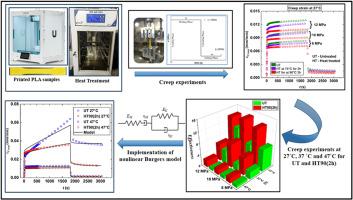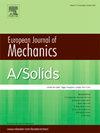Enhancing the creep resistance of 3D-printed polylactic acid at varied operating temperatures by heat treatment: An experimental and numerical analysis
IF 4.2
2区 工程技术
Q1 MECHANICS
引用次数: 0
Abstract
Creep deformation significantly affects polymer design, especially for polylactic acid (PLA), which is prone to deformation at high temperatures. This study investigates the impact of heat treatment as a post-processing technique on the short-term creep behavior of 3D-printed PLA, emphasizing the role of increased crystallinity in improving creep resistance. PLA samples were analyzed in untreated (UT) and heat-treated (HT) states at temperatures of 75 °C and 90 °C for varying curing durations, with differential scanning calorimetry employed to measure crystallinity levels. Creep tests conducted in tensile mode at room temperature (27 °C) revealed that the PLA sample heat-treated at 90 °C for 2 h (HT90(2h)) exhibited the highest resistance to creep deformation. Further evaluations at elevated temperatures (37 °C and 47 °C) indicated that HT90(2h) had a reduced creep rate than UT, with effectiveness enhanced by a factor of 1.85 at 47 °C. Increased crystallinity inhibits chain mobility in crystalline lamella, improving stiffness and creep resistance. A nonlinear viscoelastic Burgers model was utilized to predict the creep response under varying thermal and mechanical loads, with the model parameters dependent on crystallinity, stress, and temperature. The multi-curve optimization technique in MATLAB was used to analyze loading and unloading behavior at different stresses and temperatures. The linear viscoelastic Burgers model could trace the creep data at 27 °C, while the nonlinear version captured the creep response with increasing stress at elevated temperatures. Thus, heat treatment enhances PLA's creep resistance, improving its suitability for high-temperature, long-term mechanical applications.

通过热处理提高3d打印聚乳酸在不同工作温度下的抗蠕变性能:实验和数值分析
蠕变变形显著影响聚合物的设计,特别是聚乳酸(PLA),它在高温下容易变形。本研究探讨了热处理作为后处理技术对3d打印PLA短期蠕变行为的影响,强调了结晶度的增加对提高抗蠕变性能的作用。PLA样品在75°C和90°C的不同固化时间下,在未处理(UT)和热处理(HT)状态下进行分析,采用差示扫描量热法测量结晶度。在室温(27℃)拉伸模式下进行的蠕变试验表明,在90℃下热处理2h (HT90(2h))的PLA样品具有最高的抗蠕变变形能力。在高温(37°C和47°C)下的进一步评估表明,HT90(2h)的蠕变速率比UT低,在47°C时的有效性提高了1.85倍。结晶度的增加抑制了晶片中的链迁移率,提高了硬度和抗蠕变能力。利用非线性粘弹性Burgers模型预测不同热载荷和机械载荷下的蠕变响应,模型参数依赖于结晶度、应力和温度。利用MATLAB中的多曲线优化技术,分析了不同应力和温度下的加载和卸载行为。线性粘弹性Burgers模型可以追踪27°C时的蠕变数据,而非线性模型可以捕捉到高温下随应力增加的蠕变响应。因此,热处理增强了PLA的抗蠕变性能,提高了其在高温、长期机械应用中的适用性。
本文章由计算机程序翻译,如有差异,请以英文原文为准。
求助全文
约1分钟内获得全文
求助全文
来源期刊
CiteScore
7.00
自引率
7.30%
发文量
275
审稿时长
48 days
期刊介绍:
The European Journal of Mechanics endash; A/Solids continues to publish articles in English in all areas of Solid Mechanics from the physical and mathematical basis to materials engineering, technological applications and methods of modern computational mechanics, both pure and applied research.

 求助内容:
求助内容: 应助结果提醒方式:
应助结果提醒方式:


